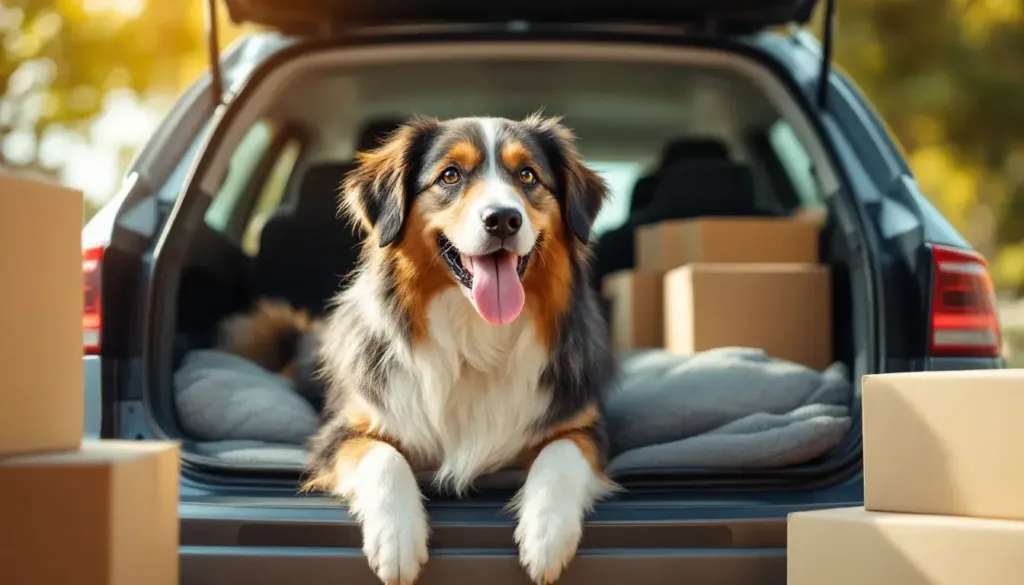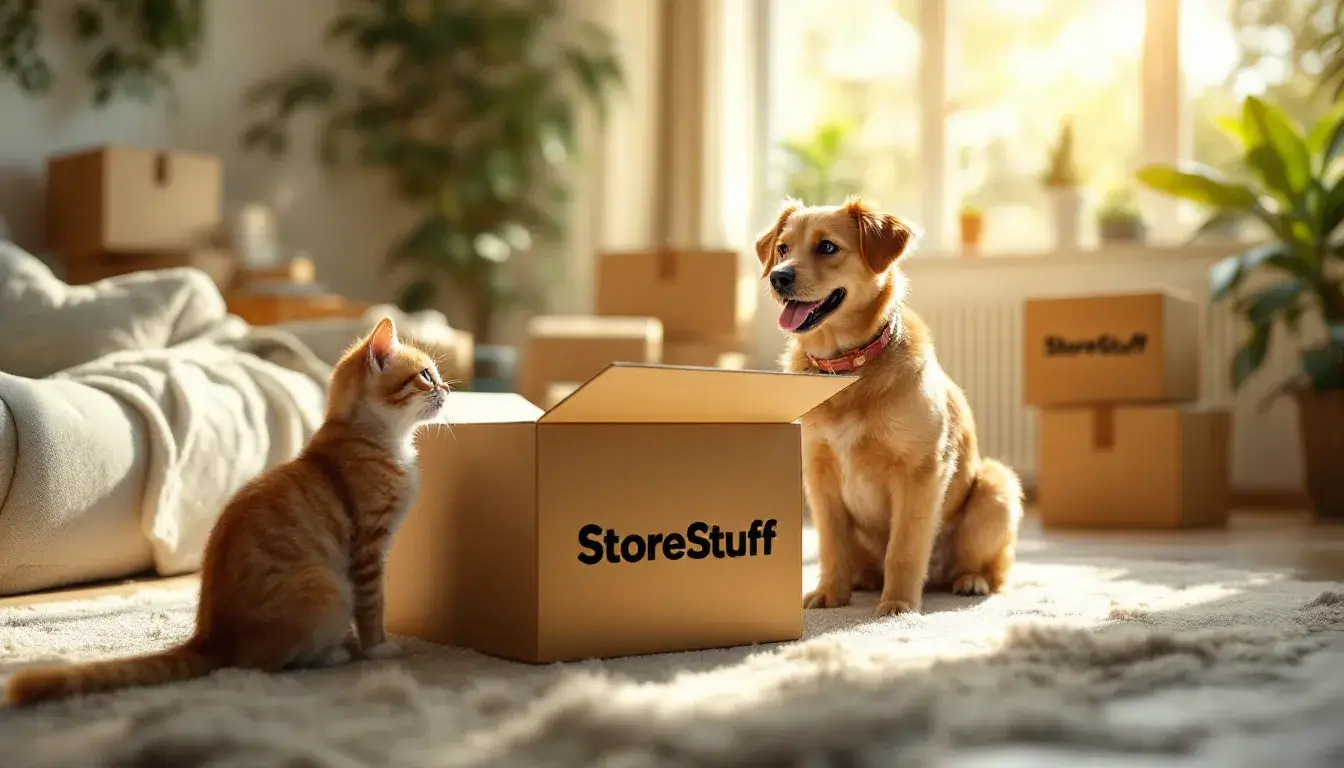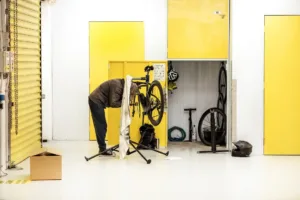Moving homes can be stressful enough with packing, logistics, and settling into a new environment. When you add pets to the equation, the complexity multiplies significantly. Our furry, feathered, or scaled companions rely on routine and familiar surroundings, making relocation particularly challenging for them. At StoreStuff, we understand that pets are family members, and their comfort during transitions matters just as much as yours.
Whether you’re moving across Wellington City, relocating to the Hutt Valley, or planning a more distant move, these five essential tips will help make the process smoother for both you and your pets while highlighting how strategic use of self-storage can alleviate common challenges.
Key Takeaways
- Create a detailed pet-specific moving plan several weeks before your relocation
- Pack a dedicated “pet essentials” box that’s easily accessible throughout the move
- Establish a quiet, safe space for your pet during the packing and moving process
- Transport pets separately from moving trucks in comfortable, secure carriers
- Set up a familiar space immediately in your new home to help pets adjust quickly
- Utilise self-storage solutions to create a less chaotic moving environment
- Maintain your pet’s routine as much as possible before, during, and after the move

1. Create a Pet-Specific Moving Plan
Before the move:
- Schedule a vet visit to ensure your pet is healthy and update any vaccinations or microchip information
- Obtain copies of veterinary records, especially if moving to a new region
- Research pet regulations in your new neighbourhood, particularly for apartment complexes or rental properties
- Create a detailed timeline that includes pet-specific tasks alongside your regular moving checklist
StoreStuff Tip: Use one of our smaller storage units to stage pet supplies and equipment you won’t need immediately, keeping your current and new home less cluttered during the transition phase.
2. Maintain Essential Supplies and Familiar Items
During a move, pets find comfort in familiar scents and objects. Pack a dedicated “pet essentials” box containing:
- Several days’ worth of food and treats
- Medications and first aid supplies
- Favourite toys and bedding
- Food and water bowls
- Grooming supplies
- Waste disposal items (litter, bags, etc.)
Keep this box easily accessible throughout the move and unpack it first at your new home to establish a sense of normality for your pet.

3. Create a Safe Space During Packing and Moving
The activity and disruption of packing can cause significant anxiety for pets. Designate a quiet room in your current home where your pet can remain:
- Furnished with familiar bedding and toys
- Away from the noise and commotion of moving
- Regularly checked on and given attention
- Maintained as the last room you pack up
This approach minimises stress and prevents escape attempts during the chaos of moving day.
StoreStuff Tip: Consider temporarily storing packed boxes at our secure facilities rather than stacking them in your home, creating more space and less disruption for your pets during the transition period.
4. Transport Your Pet Safely and Comfortably
On moving day:
- Keep pets secured in appropriate carriers or crates
- Consider boarding services for very anxious pets during the actual moving process
- Ensure proper ventilation and comfortable temperature in vehicles
- For longer journeys, plan pet-friendly accommodation and regular breaks
- Never transport pets in moving trucks or in vehicles without proper climate control
StoreStuff Tip: With 24/7 access to our storage units, you can organise your moving schedule around your pet’s needs rather than rushing the process.

5. Establish Routine Quickly in Your New Home
Once you’ve arrived at your new home:
- Set up a designated pet area first before unpacking other items
- Maintain feeding and walking schedules as close to normal as possible
- Gradually introduce your pet to different rooms rather than allowing full access immediately
- Be patient with behavioural changes and accidents as your pet adjusts
- Update ID tags and microchip information with your new address immediately
StoreStuff Tip: Gradually move items from storage into your new home to create a less overwhelming environment for your pet, allowing them to adjust to changes incrementally rather than all at once.
Conclusion
Moving with pets presents unique challenges, but with proper planning and consideration, you can make the transition a positive experience for your animal companions. By creating familiar spaces, maintaining routines, and utilising resources like StoreStuff’s flexible storage solutions, you can significantly reduce the stress that comes with relocation.
Remember that patience is key—most pets will adapt to their new environment within a few weeks. By following the tips outlined in this guide and leveraging our secure storage facilities to create a more organised move, both you and your pets can settle into your new Wellington or Hutt Valley home with minimal disruption and maximum comfort.
At StoreStuff, we’re committed to making life’s transitions smoother for all members of your family—including those with paws, tails, or wings.

Frequently Asked Questions About Moving with Pets
How far in advance should I prepare my pet for a move? Begin preparing your pet at least 3-4 weeks before your move. Start by introducing them to moving supplies like boxes and gradually adjust their routines if necessary. For more anxious pets, consider starting even earlier with desensitisation techniques.
Should I feed my pet on moving day? Feed your pet a light meal about 3-4 hours before travel to prevent motion sickness. Always ensure fresh water is available, though you may want to limit access immediately before transport to reduce accidents.
How can I help my cat adjust to a new home? Cats are particularly sensitive to environment changes. Set up a small room with familiar items first, including their litter box, food, water, and bedding. Gradually allow them to explore the rest of the house over several days as they become more comfortable.
What’s the best way to transport dogs during a move? For local moves, secure your dog in a familiar vehicle with proper restraints or in a well-ventilated crate. For longer distances, consider an airline-approved carrier if flying, or plan regular stops every 2-3 hours for walks, water, and stretching during road trips.
How do I transport fish when moving? For short moves, fish can be transported in sealed bags with water from their tank, similar to how pet shops provide them. For longer moves, consider specialised transport containers or temporarily rehoming them if the journey would be too stressful.
My pet seems stressed after moving. When should I be concerned? Some adjustment behaviours like reduced appetite, hiding, or minor accidents are normal for 1-2 weeks. If these behaviours persist beyond two weeks, intensify, or if your pet shows signs of illness, consult your veterinarian.
Should I update my pet’s microchip before or after moving? Ideally, update your pet’s microchip information before moving day. If this isn’t possible, make it a priority within the first 48 hours of relocating to ensure your pet can be returned to you if they escape during the transition.
Can moving cause health problems for my pet? Yes, the stress of moving can potentially trigger health issues in some pets, particularly those with existing conditions. Watch for signs of stress-related problems such as reduced appetite, digestive issues, or behaviour changes, and consult your vet if concerned.
Is it better to board my pet during a move or keep them with me? This depends on your pet’s temperament. For highly anxious pets or very complex moves, boarding at a familiar location may reduce stress. However, many pets adapt better staying with their owners despite the chaos, as your presence provides security.
How long will it take my pet to adjust to our new home? Most pets adapt to new environments within 2-4 weeks, though some may adjust in just days while others might take months. Maintain consistent routines, provide familiar items, and ensure plenty of attention to help ease the transition.






